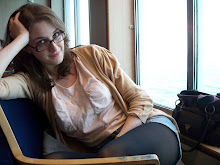The National Gallery of Scotland Complex, Edinburgh.
Whilst in Edinburgh meeting the Intermedia students from Edinburgh Art College, I had a chance to visit some exhibitions around the city, one of which was the French Drawing Exhibition, in The National Gallery Complex, on Thursday 7th April.
After handing in my essay on Impressionism to Post-Impressionism (more specifically; the notion of a modern painter) only a few days earlier, I was really interested in visiting this show due to the massive amount of knowledge I now had on the subject. The exhibition was spread out amongst four rooms; the first was full of renaissance style drawings, mostly landscapes, and Italian influences were clearly visible in the early French work. This went onto two more rooms of similar styles, each with a mix of Italian-inspired landscapes and religiously allegorical images by classically trained old masters such as Ingres. As this is an exhibition of French drawings, many of the pieces on display are of a small scale and are simply studies for the larger, finished version. I preferred this as I love sketchbooks and seeing how artists develop their ideas and thoughts into finished pieces.
My favourite from the first few rooms of work, was the 'Study of Drapery' by Joseph-Ferdinand Lancrenon. I loved this simple drawing despite it only being an unfinished study for bigger and better work, I was just completely impressed with the sheer skill and talent it takes to perfect such three-dimensions with just pencil and chalk. I enjoyed the contrast in tones between the drapes of the sheet Lancrenon had drawn; the chalk highlights contrast well with not only the dark pencil lines depicting the folds but also the beige background he chose to draw on.
 |
| 'Study of Drapery' |
The fourth room in the exhibition was what I really came to see; this was full of the Impressionist paintings. There was work by Alfred Sisley, Paul Gauguin, Cézanne, Georges Seurat, Claude Monet and Berthe Morisot who as a female painter, stands amongst a whole gallery of male artists.
As one of my favourite artists anyway, Claude Monet's 'Haystacks: Snow Effect' was my favourite painting from possibly the whole exhibition. Despite it being a painting of snow and winter weather, the orange tones glowing underneath the blue and white of the snow, provide a radiating warmth to the piece. The deep blue and grey shadow of the haystacks shows subtle contrast close up, but when you take a few steps back to view the work, it becomes unbelievably three-dimensional. The grainy texture and visible brushstrokes capture the sense of rural landscape. Monet painted the Haystacks in Giverny countless times; as Charles Baudelaire at the time wrote, the modern painter paints the eternal qualities in our transitory world. Monet painted the haystacks over and over, capturing the eternal beauty found in fleeting moments, such as sunrise and sunset, snow and ice, and sunlight and rain.
 |
| 'Haystacks: Snow Effect' |
Another one of my favourites from the exhibition was the 'Seated Nude: Study for 'Une Baignade' by Georges Seurat. I liked this study because it was totally different from the paintings recognisable of Seurat but the figure is still identifiable as a figure from his very well known work of bathers sitting alongside a river.
 |
| 'Seated Nude' |
Images:
http://www.nationalgalleries.org/
http://www.nationalgalleries.org/whatson/exhibition/5:368/20240/20422
http://www.nationalgalleries.org/index.php/collection/online_az/4:322/results/0/5196/
http://www.nationalgalleries.org/collection/online_az/4:322/result/0/19740?initial=S&artistId=5052&artistName=GeorgesSeurat&submit=1

No comments:
Post a Comment